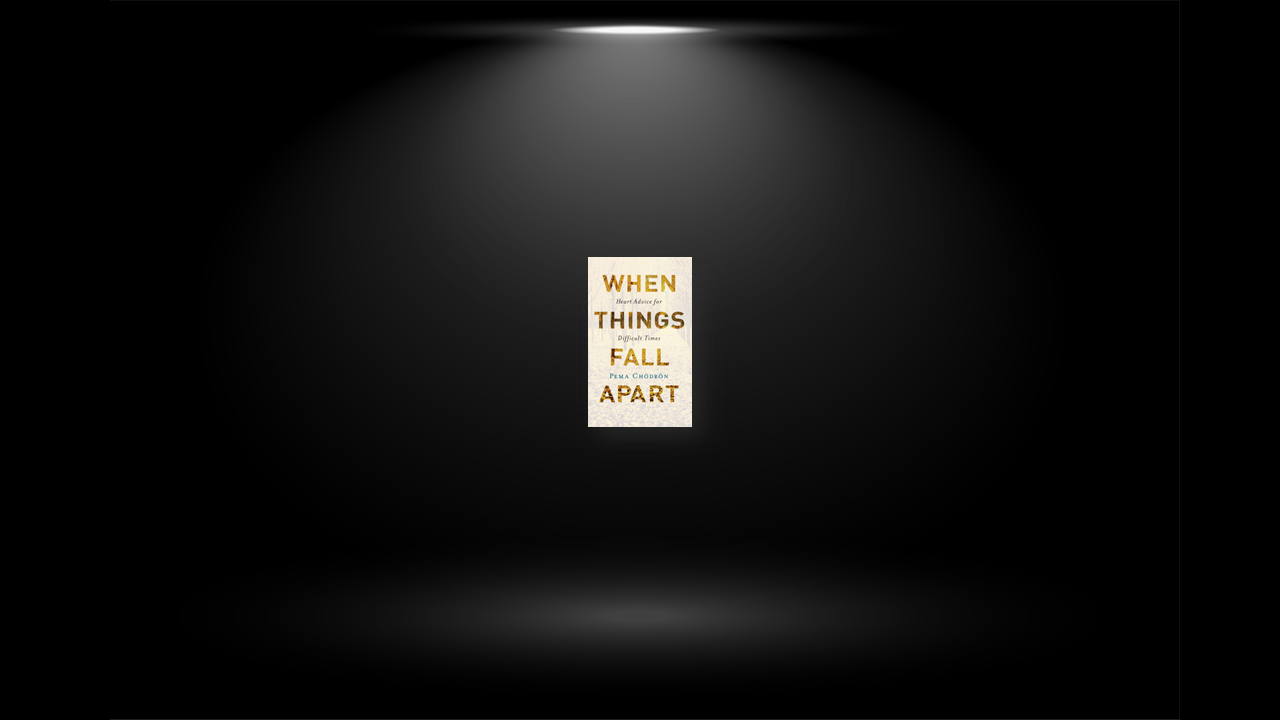Intimacy with Fear
Fear is a universal experience. Even the smallest insect feels it. We wade in the tidal pools and put our finger near the soft, open bodies of sea anemones and they close up. Everything spontaneously does that. It’s not a terrible thing that we feel fear when faced with the unknown. It is part of being alive, something we all share. We react against the possibility of loneliness, of death, of not having anything to hold on to. Fear is a natural reaction to moving closer to the truth.
If we commit ourselves to staying right where we are, then our experience becomes very vivid. Things become very clear when there is nowhere to escape. Instructions on mindfulness or emptiness or working with energy all point to the same thing: being right on the spot nails us. It nails us right to the point of time and space that we are in. When we stop there and don’t act out, don’t repress, don’t blame it on anyone else, and also don’t blame it on ourselves, then we meet with an open-ended question that has no conceptual answer. We also encounter our heart. As one student so eloquently put it, “Buddha nature, cleverly disguised as fear, kicks our ass into being receptive.”
the next time you encounter fear, consider yourself lucky. This is where the courage comes in. Usually we think that brave people have no fear. The truth is that they are intimate with fear. The trick is to keep exploring and not bail out, even when we find out that something is not what we thought. That’s what we’re going to discover again and again and again. Nothing is what we thought.
Emptiness is not what we thought. Neither is mindfulness or fear. Compassion—not what we thought. Love. Buddha nature. Courage. These are code words for things we don’t know in our minds, but any of us could experience them. These are words that point to what life really is when we let things fall apart and let ourselves be nailed to the present moment.
When Things Fall Apart
When things fall apart and we’re on the verge of we know not what, the test for each of us is to stay on that brink and not concretize. The spiritual journey is not about heaven and finally getting to a place that’s really swell. In fact, that way of looking at things is what keeps us miserable. Thinking that we can find some lasting pleasure and avoid pain is what in Buddhism is called samsara, a hopeless cycle that goes round and round endlessly and causes us to suffer greatly.
The very first noble truth of the Buddha points out that suffering is inevitable for human beings as long as we believe that things last—that they don’t disintegrate, that they can be counted on to satisfy our hunger for security. From this point of view, the only time we ever know what’s really going on is when the rug’s been pulled out and we can’t find anywhere to land. We use these situations either to wake ourselves up or to put ourselves to sleep. Right now—in the very instant of groundlessness—is the seed of taking care of those who need our care and of discovering our goodness.
Life is a good teacher and a good friend. Things are always in transition, if we could only realize it. Nothing ever sums itself up in the way that we like to dream about. The off-center, in-between state is an ideal situation, a situation in which we don’t get caught and we can open our hearts and minds beyond limit. It’s a very tender, nonaggressive, open-ended state of affairs.
To stay with that shakiness—to stay with a broken heart, with a rumbling stomach, with the feeling of hopelessness and wanting to get revenge—that is the path of true awakening. Sticking with that uncertainty, getting the knack of relaxing in the midst of chaos, learning not to panic—this is the spiritual path. Getting the knack of catching ourselves, of gently and compassionately catching ourselves, is the path of the warrior. We catch ourselves one zillion times as once again, whether we like it or not, we harden into resentment, bitterness, righteous indignation—harden in any way, even into a sense of relief, a sense of inspiration.
This Very Moment Is the Perfect Teacher
Each day, we’re given many opportunities to open up or shut down. The most precious opportunity presents itself when we come to the place where we think we can’t handle whatever is happening. It’s too much. It’s gone too far. We feel bad about ourselves. There’s no way we can manipulate the situation to make ourselves come out looking good. No matter how hard we try, it just won’t work. Basically, life has just nailed us.
It’s as if you just looked at yourself in the mirror, and you saw a gorilla. The mirror’s there; it’s showing you, and what you see looks bad. You try to angle the mirror so you will look a little better, but no matter what you do, you still look like a gorilla. That’s being nailed by life, the place where you have no choice except to embrace what’s happening or push it away.
Most of us do not take these situations as teachings. We automatically hate them. We run like crazy. We use all kinds of ways to escape—all addictions stem from this moment when we meet our edge and we just can’t stand it. We feel we have to soften it, pad it with something, and we become addicted to whatever it is that seems to ease the pain. In fact, the rampant materialism that we see in the world stems from this moment. There are so many ways that have been dreamt up to entertain us away from the moment, soften its hard edge, deaden it so we don’t have to feel the full impact of the pain that arises when we cannot manipulate the situation to make us come out looking fine.
Meditation is an invitation to notice when we reach our limit and to not get carried away by hope and fear. Through meditation, we’re able to see clearly what’s going on with our thoughts and emotions, and we can also let them go. What’s encouraging about meditation is that even if we shut down, we can no longer shut down in ignorance. We see very clearly that we’re closing off. That in itself begins to illuminate the darkness of ignorance. We’re able to see how we run and hide and keep ourselves busy so that we never have to let our hearts be penetrated. And we’re also able to see how we could open and relax.
Relax As It Is
THE MEDITATION INSTRUCTION that Chögyam Trungpa Rinpoche gave to his students is called shamatha-vipashyana meditation. When Trungpa Rinpoche first taught in the West, he told his students to simply open their minds and relax. If thoughts distracted them, they could simply let the thoughts dissolve and just come back to that open, relaxed state of mind.
After a few years, Rinpoche realized that some of the people who came to him found this simple instruction somewhat impossible to do and that they needed a bit more technique in order to proceed. At that point, without really changing the basic intent of the meditation, he nevertheless began to give the instructions a bit differently. He put more emphasis on posture and taught people to put very light attention on their out-breath. Later he said that the out-breath was as close as you could come to simply resting the mind in its natural open state and still have an object to which to return.
He emphasized that it should be just the ordinary out-breath, not manipulated in any way, and that the attention should be soft, a sort of touch-and-go approach. He said that about 25 percent of the attention should be on the breath, so that one was still aware of one’s surroundings and didn’t consider them an intrusion or an obstacle to meditation. Years later he used a humorous analogy comparing a meditator to someone all dressed up in a costume and holding a spoonful of water. One could be happily sitting there in one’s fancy costume and still be quite undistracted from the spoonful of water in one’s hand. The point was not to try to achieve some special state or to transcend the sounds and movement of ordinary life. Rather we were encouraged to relax more completely with our environment and to appreciate the world around us and the ordinary truth that takes place in every moment.


